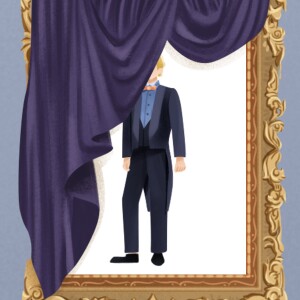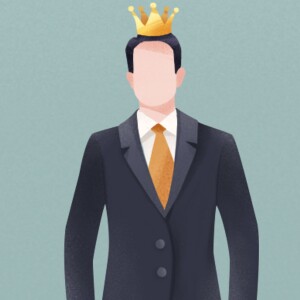Episodes

Monday Jan 02, 2023
Monday Jan 02, 2023
Think and Grow Rich Full Summary and Review by Napoleon Hill
Think and Grow Rich teaches us that for millions of people, desire can be the driver of success. Anyone interested in following this path to success must take a few straightforward steps. To start, of course, we must have a strong desire. With this yearning, we can affect the subconscious mind through autosuggestion . The subconscious mind reinforces our faith and confidence. It plants a seed. In time, it germinates, and a plan arises. What follows is action without a doubt. The method fully exploits the subconscious mind. It becomes a "middleman" that transforms desires into tangible effects. Through this process, you will realize that just thinking in the right way can make you rich.
Overview | Chapter 1
Hi, welcome to Bookey. Today we will unlock the book Think and Grow Rich. One day, in the early years of the 20th century, in Orange, New Jersey, United States, a visitor came into Thomas A. Edison's office. The guest looked a bit like a homeless person being worn out after a long and arduous journey. He introduced himself as Edwin C. Barnes. He expressed his long-standing wish to be Edison's business partner. Edison later recalled that something on Barnes' face conveyed determination. He was someone who would not give up until he achieved his goal. From his previous experience of dealing with people, Edison had learned that when someone's desire was so forceful that they would stake their entire future on their success—they were bound to succeed. Edison allowed Barnes to stay, but only as a peon and not as a business partner. Nevertheless, Barnes didn't reckon that his work was unskilled; instead, he held himself to lofty standards. And a few years later, he finally got his wish. He became Edison's true business partner and found himself working in the same room he had blundered into when he first met Edison. This is the story at the start of Think and Grow Rich. The anecdote tells us that a person's success is a function of their desire. The more intense their desire, the surer their success. How strong was Barnes' passion for success? When he was determined to become Edison's business partner, he didn't know this famous scientist, nor did he have the money to travel to the city where he was working. Facing these two difficulties, most people might have already given up their plans. But not Barnes. His desire was so strong that he climbed on a freight train to reach the destination and finally stood before Edison. When you build up determination, you can overcome any seemingly insurmountable obstacles. Think and Grow Rich is a book about effective thinking. It could be described as a book about the passion for success. In the title, the word "rich" has multiple connotations. Beyond wealth and financial success, these riches also include spiritual, mental, and bodily estates. Since it was first published in 1937, the book has sold more than 70 million copies worldwide and has influenced the paths of countless lives. The book's author, Napoleon Hill, was a pioneering motivational expert seeking to identify the principles of success. As the work's first edition has now become dated, it was edited and revised in 2004 by Arthur R. Pell, who has a Ph.D. in Philosophy. He replaced some outdated stories and anecdotes with more contemporary examples. The book, in its updated version, is now widely available and remains enduringly popular. As Hill tells it, the 'Steel King,' Andrew Carnegie, was formative in the book's genesis. Carnegie had asked Hill, a journalist at the time, to identify and interview 500 successful people with the aim of discovering their common traits and, ultimately, to share this precious secret of success with the world. Hill was delighted to accept the task, and, in the end, he interviewed more than 500 people, including important figures such as Edison, Ford, and Roosevelt. Additionally, he studied and analyzed the life stories of 25,000 successful people to eventually isolate the recipe for success that Carnegie believed must exist. With it in mind, he wrote this book, inviting you to Think and Grow Rich. Next, we will reveal to you the best parts of the book. We have split it into two sections: Part One, the desire-driven path to success; Part Two, Protecting the desire-driven path to success.

Monday Jan 02, 2023
Monday Jan 02, 2023
The Picture of Dorian Gray Full Summary and Review by Oscar Wilde
This novel recounts the story of a handsome, aristocratic youth by the name of Dorian Gray. He wished a spell on his portrait that he would retain eternal youth – a wish that ultimately came true. Thereafter, he indulged without restraint in his sensual desires. Time passed, and Dorian’s beautiful looks were unchanged by time. Meanwhile, his portrait grew more hideous day by day. Finally, aiming to destroy the traces of his life of sin contained in the portrait, Dorian stabs the canvas with a knife, resulting in his own mysterious death. In death, Dorian’s corpse transforms, becoming hideous and old. His painted portrait has its beauty restored.
Overview | Chapter 1
Hi, welcome to Bookey. Today for you, we will unlock the book The Picture of Dorian Gray. The book was the only full-length novel written by Oscar Wilde, the Irish dramatist and writer who settled in Britain. Oscar Wilde was born in Dublin, Ireland, into a prestigious family. His father was a surgeon, and his mother a poet and writer. Wilde was renowned for his flamboyant dressing style and his words of wit. He lived by his own rules and adopted a fearless lifestyle, restlessly moving between scandalous homosexual lovers and his respected family. Finally, due to his refusal to disavow his homosexuality, he ended up in jail. A pioneering voice in the field of Aestheticism, at the close of the 19th century ,Wilde was England’s most maverick genius. Oscar Wilde flourished in a British society that was governed by strict proprieties, moral and ethical codes. Everything that anyone said and did was subject to harsh restrictions. Art and literature were subject to even greater scrutiny. Slight deviations from the norms were deemed perverse, unorthodox and unacceptable. At the time, society’s prevailing view was that the value of literature and the arts lay entirely in their ability to affect people’s values through their thoughts and emotions. Consequently, art would influence people’s behavior. Fundamentally, literature and the arts were a tool for moral instruction. As such, the arts were deemed to command great educational utility. Wilde felt deep resentment towards this artistic ethos. He felt that this type of artwork crushed the artist’s imagination and destroyed the pure beauty of art; it violated art’s essence. The Picture of Dorian Gray is precisely a retaliation against such a utilitarian view of art. The novel tells the story of an aristocratic youth Dorian Gray, who is handsome in his appearance and pure at heart. But, under the seduction of a hedonist, Lord Henry Wotton, he makes a pact, trading his portrait image for his soul in exchange for eternal youth. Blessed with youth without consequence, Dorian Gray descends into an abyss of sin and evil. On account of its evocation of moral issues, the novel’s publication stirred much controversy in Britain. Wilde himself was ambivalent. He never explicitly stated his own position. However, the British literary establishment dubbed the novel “a tale spawned from the leprous literature of the French decadents—a poisonous book, the atmosphere of which is heavy with the mephitic odors of moral and spiritual putrefaction—a gloating study of the mental and physical corruption of a fresh, fair and golden youth”. Thereafter, Wilde’s novel was forever regarded as proof of his desire to attack and damage social mores. In the novel’s preface, Wilde offered a retort to public censure. He wrote: “There is no such thing as a moral or immoral book. Books are well-written, or badly written. That is all.” So, what sort of story lies within the pages of this book? Why did it provoke such fiery debate? We will now interpret this book for you in the following three parts: In Part One, we will summarize the novel’s plot; In Part Two, we will provide an in-depth analysis of the novel’s key characters; In Part Three, we will interpret Wilde’s perspectives on art as it is embodied in the novel.

Sunday Jan 01, 2023
Sunday Jan 01, 2023
The Five Love Languages Full Summary and Review by Gary Chapman
Many people think that marriage is the grave of love, and a lot of couples fight with each other or have marriage crises because of trivial things. But they are always close to each other when they are in love. So what turns these intimate relationships into ones ripe with conflict? This book will tell us why as well as discuss the primary reason why communication is so important, and how we can express love in proper ways. It also provides effective ways that will point us in the direction of how to resolve marriage crises.
Overview | Chapter 1
Hi, welcome to Bookey. Today, we will unlock the book by Gary Chapman called “The Five Love Languages.” It is common that relationships change after marriage, even though many couples were happy when they were in love before that. They may fight with each other more frequently after marriage. More seriously, these conflicts can lead to emotional crises or even divorce. What’s going on? The problem is that we all have different love languages, which means we all have different ways of expressing love. When getting along with our partner, we express our love based on our own ideas. These different ideas mean people will eventually end up with different love languages. This is the point: Does your partner understand your way of expressing love? Will he or she feel that you love him? This happens because we ignore the fact that everyone has different love languages. Your partner might not feel your love when you express love in your own ways. Why are love languages important? In the book, the author says that giving and receiving love is at the center of every single adult’s sense of wellbeing. Marriage is designed to satisfy our needs for an intimate relationship and love. Feeling loved is the most important emotional need for us. In his book, the author uses a good metaphor: in every child’s heart, there is an “emotional love tank” waiting to be filled with love. It’s only when a child feels truly loved that he can grow up healthy and happy. However, when the love tank is empty, the child will exhibit problematic behaviors. Adults are the same. If our love tank is empty and we cannot feel loved, our marriage will have problems. So how can we fill our love tank and reap good results in a marriage? The love language teaches us how to fill our love tank in the proper ways, and this book will tell us how to do it in detail. Gary Chapman is a prominent relationship coach who has met lots of couples who were faced with marriage issues. Through deep communication, he found that the reason for the marriage crisis was that both partners used the wrong love languages to get along with each other. Therefore, he wrote this book to help people discover their love languages and have a better marriage. His other book, “Things I Wish I'd Known Before We Got Married” discusses common traps that can be found in a marriage. If you are interested in it, please listen to our bookey of that book. Next, we will cover the essence of “The Five Love Languages” in six parts. We will learn how to discover our partner’s love language as well as our own to have a happy and healthy marriage. Part One: Love Language #1: Words of Affirmation; Part Two: Love Language #2: Quality Time; Part Three: Love Language #3: Gifts; Part Four: Love Language #4: Acts of Service; Part Five: Love Language #5: Physical Touch; Part Six: Discover Your Primary Love Language.

Sunday Jan 01, 2023
Sunday Jan 01, 2023
The 48 Laws of Power Full Summary and Review by Robert Greene Looking back on human history, you will find that there has been no time in which people did not play games of power. The real world is complicated and we often have wonderful aspirations which are out of our reach. Rather than passively respond to complex situations, we should proactively study the laws of power. This book analyses a large number of case studies of successes and failures, and summarizes 48 laws of success to help us take the initiative and develop our abilities for when we find ourselves in complicated situations. Overview | Chapter 1Hi, welcome to Bookey. Today we will unlock the book The 48 Laws of Power. Many people see power as a subject that refers to political tactics, which has nothing to do with them. As long as we are honest with others and stay away from political games, then surely we can avoid power struggles. But in fact, this is just a naïve and fanciful way of thinking. Niccolò Machiavelli, the Italian political thinker and author of The Prince, once said: “Any man who tries to be good all the time is bound to come to ruin among the great number who are not good.” In human society the game of power is always being played, from grand political schemes to various struggles in our personal lives. Everybody lives in a game of power, playing either an active role or a passive role, and none of us can avoid it. Some people believe that playing power games is insidious and immoral, and yet power has nothing to do with morality. Power is a concept that goes beyond ethics; it is the skill and ability to perceive changes in the situation and to make decisions based on objective reality and desired results rather than on the moral intentions of the opponent. Human nature is complex. People have a civilized and noble side, but they have a cunning and dark side, too. In order to reach their goals, people often use all kinds of ways to camouflage and conceal. How should we protect ourselves from being confused or used by others? How can we clearly see the real motivations behind their actions through so many layers of fog? How can we make correct decisions? This book shows us how we can have our own strength in the struggle for power. The authors of this book are American author Robert Greene and publisher Joost Elffers. Robert is a freelance writer as well as an editor and script writer. To write The 48 Laws of Power, he quit his job and plunged into a sea of literature, reading over 200 books and collecting a huge amount of historical material spanning more than 3000 years. He analyzed a great number of historical cases of failures and successes, and from this, he concluded the 48 laws of power and set forth his idea of the principles and rules of power. The power described in this book doesn’t just refer to political tactics but to more general concepts too, and can be understood as a kind of control and manipulation. Of course, here we also need to remind you that the values and morality of “obtaining power is the ultimate goal” described in the book are a little skewed, so we should look at them with a critical eye. However, the laws of power unlocked in this book contain insights which are profound and thought-provoking. Due to restrictions on time and length, we can only choose a few of the 48 laws summarized in this book. We have divided them into three sections which we will describe in more detail: Part One,: Handling your relationships carefully to maximize your power. Part Two: How powerful people stay powerful. Part Three: Choosing an appropriate strategy according to the specific situation.

Friday Dec 30, 2022
Friday Dec 30, 2022
The 7 Habits of Highly Effective People Full Summary and Review by Stephen Covey
This book, as the title says, is about the seven habits of highly effective people. It teaches us how to achieve victory from the private to the public spheres, thereby making a tremendous change in life and career, and attaining both success and happiness. Known as the “Bible” of the American business community and government management department, the book is included in the training course of the Fortune Global 500 corporations, and is ranked by Forbes as one of the ten most influential management books in history.
Overview | Chapter 1
Hi, welcome to Bookey. Today we will unlock the book The 7 Habits of Highly Effective People: Powerful Lessons in Personal Change. It’s mainly about how to become a highly effective person, and attain both success and happiness. Many of us have shared an experience of having so many things to do every day, and feeling that time is not enough. Despite working all day long and feeling exhausted at the end of the day, we can’t seem to get all the work done. However, there are some people around us who barely work overtime, but still do a great job. They can even enjoy some leisure time. Why is that? Are they born with a higher IQ? The truth? This is because some of them have developed good habits of high effectiveness, which leads to a comfortable yet highly effective life. Perhaps you are wondering: what is high effectiveness? High effectiveness refers to the balance between production and production capacity, which is referred as the P/PC balance in this book. P stands for production, and PC stands for production capacity. Have you heard of the fable about the goose and the golden egg? A farmer has a goose that can lay golden eggs, and he soon becomes fabulously rich. However, the greedy farmer becomes unsatisfied with only one golden egg per day, so he kills the goose, hoping to take out all of the golden eggs from it. To his surprise, there are no golden eggs inside the goose. The goose is dead, so there’s no way he can get another golden egg. The farmer has ruined everything for himself. In the above fable, what is produced is the golden eggs, and production capacity, namely, the producing asset or capacity to produce, is the goose that lays golden eggs. If we “focus on golden eggs and neglect the goose,” we will lose both the goose and the eggs. Conversely, if we “only take care of the goose with no aim toward the golden eggs,” we can feed neither ourselves nor the goose. Therefore, only when you take good care of the goose can you get golden eggs. And only when you control your desire to ask too much from the goose can you keep it alive. Likewise, only when you strike a balance between work performance and well-being, can you attain real effectiveness and make greater achievements. This book tells us exactly the specific ways that can help you easily achieve high effectiveness. The author of this book, Stephen Covey, was a world-renowned management guru and a well-respected leadership authority. He has a high and long-standing reputation in leadership theories, family and interpersonal relationships, and personal management. Recognized as “a master of thoughts” of the American academic community, Covey was named “one of the twenty-five most influential people in American history” and “a mentor of human potential” by Time magazine. The 7 Habits of Highly Effective People: Powerful Lessons in Personal Change, is also known as the “Bible” of the American business community and government management department. It’s ranked as one of the ten most influential management books in history by Forbes. It will teach you seven good habits. These habits will help you become successful and highly effective with little struggles, achieve personal and interpersonal effectiveness, and make a tremendous change in your life and career.

Friday Dec 30, 2022
Friday Dec 30, 2022
Rich Dad Poor Dad Full Summary and Review by Robert T. Kiyosaki
You probably have a stable and decent job, but you do not dare to rest for a second, because you are afraid that, should there be an unexpected accident, you will lose everything you have. How can you become a truly rich person, who does not have to worry about livelihood and can make financial freedom a reality? This book will tell you this: being hardworking is not enough; you also need a bit of financial intelligence. This book is just about to help you develop your financial intelligence and understand the secrets behind the mindset of the rich.
Overview | Chapter 1
Hi, welcome to Bookey. Today, we will unlock the book Rich Dad Poor Dad, a groundbreaking book in the field of money management. You probably already have a stable and decent job, but you do not dare to rest for a second, because you are afraid that, should there be an unexpected accident, you will lose everything you have. How can you become a truly rich person, who does not have to worry about making ends meet and can make financial freedom a reality? This book will tell you this: being hardworking is not enough; you also need a bit of financial intelligence. This book is about to change the way you think about wealth and teach you how to think like the rich, paving the way to your financial freedom. The author of this book, Robert T. Kiyosaki, is known as ‘The Godfather of Millionaires’ and ‘The Money Coach’. He is a popular financial expert. Through fun stories featuring him and ‘two dads’, he shows us the collision between two contrasting mindsets about money. The ‘poor dad’ (in the story) is Robert’s biological father. He is a well-educated man with a Ph.D. degree as well as a stable job and a decent income. However, he is often caught in debt. The poor dad represents the mindset of most people who do not know how to deal with money. The rich dad is his friend Mike’s dad. He is an entrepreneur who did not graduate from high school. Although ‘rich dad’ does not have deep expertise, he has excellent skills in managing money. The rich dad is the teacher of the author, Robert, in money management. He represents the mindset behind accumulating wealth successfully and becoming rich. He will teach you the concept of wealth that you must have to become a wealthy person. In this bookey, we will walk through the following three aspects with you. Firstly, think like the rich. Secondly, learn how to tell the difference between an asset and a liability. Thirdly, invest like the rich.

Thursday Dec 29, 2022
Thursday Dec 29, 2022
How to Win Friends and Influence People Book Summary and Notes
A practical work on interpersonal relations, this book takes an in-depth look at human nature and taps into the hidden weaknesses of humanity. Through reading this book, one can get to know more about themselves and make further self-improvements. This book became a worldwide bestseller immediately after its debut. It has been translated into almost every major language in the world within decades of its release. It’s hailed as the bible of social skills. In 2011, it was number 19 on Time Magazine's list of the 100 most influential books.
Overview | Chapter 1
Hi, welcome to Bookey. Today we’ll unlock the book How to Win Friends and Influence People. Many of us are familiar with or have even read this book. It has continued to gain popularity and receive acclaim from readers around the world. It has also been published in many editions. Data shows that this book has sold tens of millions of copies worldwide, a truly remarkable number in the history of publication. It provides people with guidelines for dealing with others, in addition to sharing many ideas about how to live a happy life. Numerous people have benefited from it. Ever since Carnegie revealed the secret to harmonious relationships to many people around the world, other books on the subject of interpersonal relationships have emerged. Due to his enormous influence, Carnegie has been praised as one of the greatest experts in self-help and interpersonal relationships. It may be hard to imagine that, while Carnegie is now a revered mentor in the self-help industry, he used to suffer a lot from his inability to effectively deal with people. Carnegie was not born a genius of social skills. He learned from his own personal experiences and turned them into assets. Carnegie was born in the 1880s in a small town in Missouri. His family was poor, so he was always hungry and cold. Due to malnutrition, little Carnegie was rather skinny and short, making his ears, which were disproportionately big compared to his head, seemed even larger. Because of his big ears, little Carnegie was often teased by his classmates. One day, he got into a fight with a boy in his class. He said something very mean to the boy, who became so furious that he threatened to cut off Carnegie’s ears. Carnegie was terrified. In the next few days, he kept worrying about his ears being cut off. He was even too scared to fall asleep, fearing that his ears would be cut off in his dreams. But this was not his only concern. When he was a kid, Carnegie would dwell on anxieties to the point of tears. He worried about so many absurd things, for example, being buried alive like a seed, getting killed by a lightning strike, or going to hell after dying. He also worried that no girl would ever want to marry him, or that he would be kidnapped by aliens. Later on, Carnegie realized that most people’s worries were not necessary, because there was a 99% chance that they wouldn’t happen. After a long period of anxiety and lack of confidence when growing up, he attended the State Teachers’ College in Warrensburgh, Missouri. Here, he took an interest in debating, and became very fond of it. So, he attended debates and public speaking competitions frequently, painstakingly honing his speaking skills. He won the majority of contests in which he participated, and gained great confidence from giving speeches. Gradually, he realized that this could be his life-long career. Afterward, Carnegie started to give inspirational speeches around the world. He wrote many self-help books, like How to Win Friends and Influence People, How to Stop Worrying and Start Living, and How to Enjoy Your Life and Your Job. His courses teaching interpersonal skills started to be held around the world. A worried little boy with low self-esteem finally became the great mentor of self-help we know today.

Wednesday Dec 28, 2022
Wednesday Dec 28, 2022
Atomic Habits Book Summary and Review
Why do so many of us fail to lose weight? Why can't we go to bed early and wake up early? Is it because of a lack of determination? Not at all. The thing is, we are doing it the wrong way. More specifically, it's because we haven't built an effective behavioral system. James Clear finds that it takes four steps to form a habit. Cue, craving, response, and reward are the pillars of every habit. This book summarizes the four laws that correspond to the four steps to help you quickly build good habits or, counterintuitively, break bad ones.
Overview | Chapter 1
Hi, welcome to Bookey. Today we'll unlock the book Atomic Habits: An Easy & Proven Way to Build Good Habits & Break Bad Ones. Imagine you're sitting in a plane, flying from Los Angeles to New York City. Due to a mysterious and undetectable turbulence, your aircraft's nose shifts more than 7 feet, 3.5 degrees to the south. After five hours of flying, before you know it, the plane is landing. However, it’s not landing in New York City, but in Washington Dulles International Airport, which is 225 miles from your destination! A minimal change over time can make a significant difference, and the direction of an airplane is a straightforward example. In the same way, a slight change in your daily habits can steer your path to a completely different destination. That's the incredible power of habits. Everyone wants to control their lives and not be led by the nose by bad habits. We'll make New Year's plans, vow to lose weight or quit smoking, keep reading or running, but these resolutions will often come to naught. Is it because of a lack of determination? No, we are doing it the wrong way. More specifically, it's because we haven't built an effective behavioral system. James Clear finds that it takes four steps to form a habit. Cue, craving, response, and reward are the pillars of every habit. This book summarizes the four laws that correspond to the four steps to help you quickly build good habits or break bad ones. There isn't just one way to develop good habits, but this book presents an ideal path the author knows. It's suitable for everyone who is seeking a step-by-step approach. The author of this book is James Clear, a habit researcher and author of the New York Times bestseller. Over 500,000 people subscribe to his email newsletter, and his website receives millions of visitors each month. Clear is the founder of the famous The Habits Academy, which is the leading platform for individuals and organizations that are interested in developing better habits in life and work. More than 10,000 leaders, managers, teachers, and coaches have graduated from The Habits Academy.

Thursday Dec 01, 2022
Thursday Dec 01, 2022
The Little Prince Full Summary and Review by Antoine de Saint-Exupéry
The Little Prince is a children’s story that touches even the adults’ hearts, as the author said, “All grown-ups were once children.” From the point of view of a pilot, the book recounts the journey of a young prince who travels to Earth from an alien planet. The irony, fantasy, truth, and philosophy embedded in the story have made it one of the most famous children’s books in France and later across the world. It is hailed as one of the most read books after the Bible.
Overview | Chapter 1
Hi, welcome to Bookey. Today we will unlock the book The Little Prince. In the 1940s, World War II swept the world. It brought not only chaos, but also spiritual decline. German philosopher Martin Heidegger described the era as “the destitute time” and “the time of world’s night”. When the darkness descended upon the people in the turbulent age, how should they free themselves from the difficult circumstances? Famous French writer and aviator Antoine de Saint-Exupéry gave his answer in The Little Prince. Both a writer and a pilot, Saint-Exupéry was not the first who wrote about aviation, but he was the first author to explore life and civilization through aviation. In his works, Saint-Exupéry was committed to re-explore spiritual life, which he believed was above intelligence and in line with human needs; it would guide people in their journey of self-discovery and lead to their true essence. In the wake of the war, people, devastated, craved warmth and wisdom to comfort the anguish and vulnerability of their souls. It was where The Little Prince came in. To this day, this book still serves the purpose as the author wished: to nourish people’s souls. It is a timeless story that remains a solace to us all. The Little Prince is a children’s story that touches even the adults’ hearts, as the author said, “All grown-ups were once children.” From the point of view of a pilot, the book recounts the journey of a young prince who travels to Earth from an alien planet. The irony, fantasy, truth, and philosophy embedded in the story have made it one of the most famous children’s books in France and later across the world. It is hailed as one of the most read books after the Bible. The young blond prince with melancholy eyes and a long scarf that flutters in the wind crosses the vast desert and into our hearts, bringing generations of readers a beautiful tale and the wisdom it contains.

Thursday Dec 01, 2022
Thursday Dec 01, 2022
The Alchemist Full Summary and Review by Paulo Coelho
A young shepherd named Santiago has a recurring dream, in which he sees a treasure hidden at the Egyptian pyramids. To seek the treasure, the boy sells his sheep and embarks on a strenuous journey, crossing the Sahara Desert. Throughout his trip, he experiences a series of strange encounters. Under the guidance of an alchemist, he reached the pyramids, only to discover where the treasure really was. In the end, he has managed to gain wealth and find his true love, turning the dream he sought all along into reality.
Overview | Chapter 1
Hi, welcome to Bookey. Today we will unlock the book The Alchemist. The story begins when a young shepherd named Santiago has a recurring dream, in which he sees a treasure hidden at the Egyptian pyramids. To seek the treasure, the boy sells his sheep and embarks on a strenuous journey, crossing the Sahara Desert. Throughout his trip, he experiences a series of strange encounters. Under the guidance of an alchemist, he reached the pyramids, only to discover where the treasure really was. In the end, he has managed to gain wealth and find his true love, turning the dream he sought all along into reality. Known as one of the few internationally acclaimed literary works, this book has been translated into 68 languages and holds a Guinness World Record as the most translated book by a living author. Being sold over 35 million copies in 160 countries, it is one of the best-selling books of all time. With a broad, compassionate, and unique perspective as well as crystal-clear writing, Coelho combines philosophical ideas, religious miracles, and fables. His novel has moved not only the common people across the world, but also powerful politicians, famous celebrities, and entrepreneurs, garnering hundreds of millions of readers. Even those who are illiterate are drawn to the wondrous world he depicted. In 2007, due to the influence of his works, Coelho became a UN Messenger of Peace. Next, let us explore Santiago’s adventure from four different angles: Part One, a shepherd’s treasure hunt; Part Two, Santiago’s secrets to success; Part Three, symbolism; Part Four, love is the essence.








